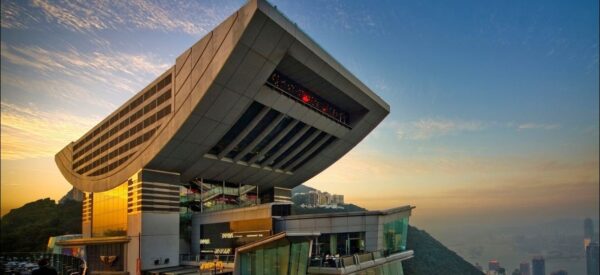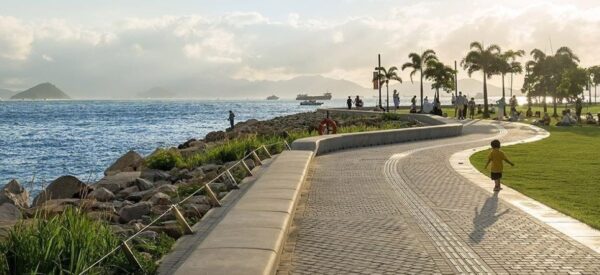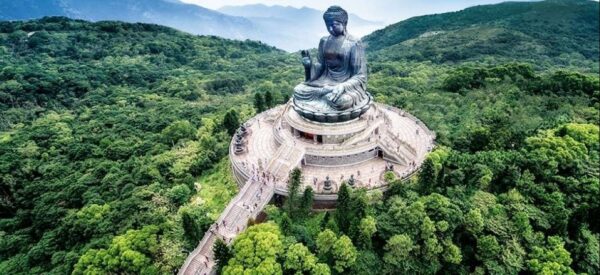While the world – and tourism – paused during the pandemic, Hong Kong used the unavoidable downtime to nevertheless continue developing its infrastructure and attractions for the day when tourism resumed. And that day has come.
Hong Kong Director for the Americas Michael Lim says both first-time and returning visitors will find a city with a new look and amazing new experiences that compliment or enhance traditional favourite activities and cultural touchstones, such as discovering Old Town Central, or ascending Victoria Peak for unparalleled views of the harbour and skyline.
Here are some of the highlights that visitors won’t want to miss:
PEAK TRAM

The Peak is considered by many to be Hong Kong’s most spectacular destination, but even the journey reaching it can be equally as spellbinding. Taking approximately six minutes and rising from 33 m. to 396 m. above sea level along a 1,278-m.-long track, the journey is a visually memorable experience as skyscrapers glide past at what appear to be impossible angles while the Peak Tram makes its ascent.
The Peak Tram began operation in 1888 and today is one of the world’s oldest funicular railways. And now, having returned after a major facelift and upgrade project, the iconic tourist attraction features new tramcars with larger panoramic windows; the replacement of all haulage, control, and signalling systems; new ropes and track rails; and the refurbishment of its Central and Peak Termini to facilitate the beautiful new, larger capacity tramcars.
In addition to reducing passenger waiting times by over 70%, visitors are greeted by a dynamic, brand-new entertainment experience that introduces five engaging zones that include: Eye of Infinity, The Beating Heart, An Icon is Born, Once Upon a Tram, and Go Wild at the Peak at the Central Terminus.
OLD TOWN CENTRAL
One of the oldest yet also most dynamic districts in the city, Old Town Central – encompassing the sloped streets and small alleys of Central and Sheung Wan – encapsulates Hong Kong’s rich and diverse spirit. A place where century-old temples share the same streets as fashion-forward concept stores, or where authentic tea houses coexist with modern art galleries, the colourful neighbourhood is at once old and new while also being proudly local and unmistakably global.
Immensely walkable and brimming with attractions, this neighbourhood is perfect to experience on foot. There’s plenty to discover, from heritage buildings and art institutions to local eats and fun souvenirs.
And, of course, historic Central Market, which dates to 1842, but which has seen multiple transformations since – the latest iteration coming in August 2021. With the motto ‘Playground for All,’ the three-level establishment is split into three core concepts: a boundary-less spatial experience, a green urban oasis, and a curated heritage experience.
Different entrances lead into the ground floor space, while shops are designed as individual islands separated by green partitions. More than 500 mini lampshades – a symbol of the classic wet market – hang above the ground floor entrance, their traditional red and contemporary bronze symbolizing the meeting of old and new. The market’s original built structure remains mostly unchanged, with the historical red brick walls and hanging clock of the grand staircase kept as a testament to its predecessor. Greenery fills the grounds both indoors and outdoors, including an air-filtrating arcade of 400 green plants in the corridor. Of the original market stalls, 13 remain, and displays of traditional shop signs and signage hark back to Hong Kong’s past.
SHAM SHUI PO
Many of Hong Kong’s unique neighbourhoods recall the authentic Hong Kong beyond the glamourous central city. The historically blue-collar Sham Shui Po neighbourhood, for example, offers a lot of cheap but cheerful experiences that can’t be found anywhere else in the city. Instead of glitzy, glass-panelled skyscrapers, here you’ll find buildings that hide a rich history behind their humble façades – many now adorned with colourful street art.
Don’t come here for a fancy gourmet meal. Instead, come here for Michelin-recommended noodles and snacks that only cost under CDN$10. And to shop – sifting through anything and everything for sale at bargain prices on Fuk Wing, or Toy, street, and open-air street markets, including the wet food market on Pei Ho Street.
From traditional temples built by early immigrants to the Ex-Sham Shui Po Service Reservoir – a historic Romanesque cistern featuring granite piers, red brick arches, and concrete cove ceilings that can now be toured (individually or in groups) – to concept stores and coffee shops that are bringing a new energy and attitude to the bustling district, visitors will discover all the simple pleasures that give Sham Shui Po its distinct charm.
WEST KOWLOON DISTRICT

A growing arts and cultural hub with performance and exhibition centres, green open spaces, a growing selection of cafés and restaurants, and a waterfront promenade perfect for enjoying sunset views and evening strolls, the West Kowloon Cultural District stretches from MTR Austin Station to the waterfront west of MTR Kowloon Station, and all venues are within easy distance of public transport.
- A highlight of the district is the Hong Kong Palace Museum, which is dedicated to presenting Chinese history, art, and culture from a new perspective, while advancing dialogue among world civilizations through international partnerships. The museum presents the finest objects from the Palace Museum and other important cultural institutions around the world.
- There is also M+, Asia’s first global museum of contemporary visual culture, featuring collections spanning 20th- and 21st-century visual art, design, and architecture, moving image and Hong Kong visual culture. The expansive podium cantilevers above ground and includes 17,000 sq. m. of exhibition space across 33 galleries, three cinema houses, the Mediatheque, Learning Hub, and Roof Garden that faces Victoria Harbour.
- The Art Parkoffers open green spaces where visitors can relax, play, or picnic on the lawns, and a long waterfront promenade perfect for sunset views of the harbour. Art Park is also a vibrant venue for open-air performances, exhibitions and other cultural events, and home to occasional street performers, a gourmet food truck and multiple restaurants and cafés.
- Freespace– Hong Kong’s centre for contemporary performance in the heart of the Art Park – presents multi-genre performances and events, and showcases emerging and established artists from Hong Kong and around the world.
- Located at the eastern end of the district, the Xiqu Centreis an award-winning venue showcasing world-class productions of Cantonese opera and other regional forms of Chinese opera (xiqu). The Centre also hosts regular film screenings, workshops, talks, exhibitions, and guided tours.
And, of course, there is an endless list of traditional sites, sounds and activities, in Hong Kong that help make the city one of the world’s most unique destinations.
Here are just a few:

- On Lantau island at the Po Lin Monastery, the Tian Tan ‘Big’ Buddha is a 34-m. high bronze statue that requires 268 steps to reach. And that’s after getting there via cable car from Tung Chung MTR station, a ride that is clearly half the fun.
- Hong Kong is famous for its flowers, and the markets that sell them – especially at Chinese New Year. But visiting a Flower Market at any time of year makes “scents.”
- Temple Street Night Market is a kaleidoscope of colour, a delightful hodgepodge of stalls, cafés, and mystic arts. Near the temple rows of fortune tellers predicting the future through such means as palm and ear readings, as well as bird-assisted tarot card reading.
- Star Ferry, which sails across Victoria Harbour every 10 minutes, is a great way to see how the locals travel, and to get a magnificent view of the harbour – all for just a few dollars.
- Hong Kong’s classic trams have earned Guiness World Record recognition as the ‘largest double-decker tram fleet in service.’ The trams ply the north corridor of the main island from morning until midnight; be sure to sit on the top deck for the quintessential sightseeing experience.
- Returning mega events to the city in 2023 include the annual Hong Kong Wine & Dine Festival, which will make its grand return to the Central Harbourfront from Oct. 26 to 29. Set against the breathtaking Victoria Harbour skyline, it offers a sensational outdoor wine and dine experience, with tasting and cooking workshops, as well as live entertainment. And the festival continues to delight taste buds in November: for four weeks, Hong Kong locals and visitors can share fantastic gastronomic experiences and a myriad of special offers from hundreds of bars and restaurants.
And in October, Hong Kong Cyclothon offers a rare opportunity to cycle through the diverse cityscape of Hong Kong. Alongside thousands of cyclists, it’s a breathtaking ride and exhilarating event!
- Chinese New Year is the highlight of the Hong Kong Cultural calendar. It’s a time of lavish fireworks, a world-famous night street parade, elaborate banquets, and glittering illuminations. Symbolizing prosperity and unity, while invoking good fortune for the year ahead, this festival is cherished and celebrated across the city. In the weeks leading up to the event Hong Kong is abuzz with activity as preparations for the holiday get underway. Visitors do not have to look hard (or at all!) to find a lion dance, a colourful, noisy, and athletic display aimed at frightening away evil spirits and bringing good luck.

